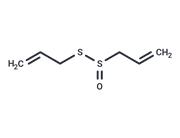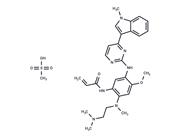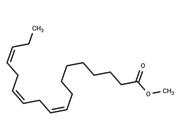| Name | Osimertinib |
| Description | Osimertinib (AZD-9291) is an EGFR third-generation inhibitor that inhibits the T790M resistance mutation produced by second-generation EGFR inhibitors with irreversible and oral activity. Osimertinib has antitumor activity for the treatment of EGFR-mutated non-small-cell lung cancer. |
| Cell Research | AZD-9291 is dissolved in DMSO and stored, and then diluted with appropriate medium before use[1]. PC-9 cells are seeded into T75 flasks (5×105 cells/flask) in RPMI growth media and incubated at 37°C, 5% CO2. The following day the media is replaced with media supplemented with a concentration of EGFR inhibitor equal to the EC50 concentration predetermined in PC-9 cells. Media changes are carried out every 2-3 days and resistant clones allowed to grow to 80% confluency prior to the cells being trypsinised and reseeded at the original seeding density in media containing twice the concentration of EGFR inhibitor. Dose escalations are continued until a final concentration of 1.5 μM Gefitinib, 1.5 μM Afatinib, 1.5 μM WZ4002 or 160 nM AZD-9291 are achieved[1]. |
| Kinase Assay | ACY-1215 is dissolved and subsequently diluted in assay buffer [50 mM HEPES, pH 7.4, 100 mM KCl, 0.001% Tween-20, 0.05% BSA, and 20 μM tris(2-carboxyethyl)phosphine] to 6-fold the final concentration. HDAC enzymes are diluted to 1.5-fold of the final concentration in assay buffer and pre-incubated with ACY-1215 for 10 minutes before the addition of the substrate. The amount of FTS (HDAC1, HDAC2, HDAC3, and HDAC6) or MAZ-1675 (HDAC4, HDAC5, HDAC7, HDAC8, and HDAC9) used for each enzyme is equal to the Michaelis constant (Km), as determined by a titration curve. FTS or MAZ-1675 is diluted in assay buffer to 6-fold the final concentration with 0.3 μM sequencing grade trypsin. The substrate/trypsin mix is added to the enzyme/compound mix and the plate is shaken for 60 seconds and then placed into a SpectraMax M5 microtiter plate reader. The enzymatic reaction is monitored for release of 7-amino-4-methoxy-coumarin over 30 minutes, after deacetylation of the lysine side chain in the peptide substrate, and the linear rate of the reaction is calculated[1]. |
| In vitro | In the EGFRm+ (PC9) and EGFRm+/T790M (H1975) tumor models, oral administration of AZD9291 (5 mg/kg) effectively inhibits AKT and ERK signaling pathways as well as EGFR phosphorylation in tumors, leading to tumor regression. |
| In vivo | In mutant EGFR cell lines, AZD9291 effectively inhibits cell proliferation. |
| Storage | Powder: -20°C for 3 years | In solvent: -80°C for 1 year | Shipping with blue ice. |
| Solubility Information | Ethanol : 22 mg/mL (44 mM)
DMSO : 55 mg/mL (110.09 mM)
10% DMSO+40% PEG300+5% Tween 80+45% Saline : 9.2 mg/mL (18.41 mM), Suspension. Please add co-solvents sequentially, clarifying the solution as much as possible before adding the next one. Dissolve by heating and/or sonication if necessary. Working solution is recommended to be prepared and used immediately.
H2O : < 1 mg/mL (insoluble or slightly soluble)
|
| Keywords | AZD 9291 | Inhibitor | Ba/F3 cells | Osimertinib | H1975 | EGFR | PC-9 | tumor xenograft model | ErbB-1 | AZD9291 | HER1 | inhibit | cancer | Epidermal growth factor receptor |
| Inhibitors Related | Lidocaine Hydrochloride hydrate | Lapatinib | Afatinib Dimaleate | Erlotinib hydrochloride | Erlotinib | Neratinib | Chalcone | Genistein | Khellin | Gefitinib |
| Related Compound Libraries | Kinase Inhibitor Library | Tyrosine Kinase Inhibitor Library | Anti-Cancer Clinical Compound Library | Inhibitor Library | FDA-Approved Drug Library | FDA-Approved Kinase Inhibitor Library | Anti-Cancer Approved Drug Library | Bioactive Compounds Library Max | Anti-Cancer Active Compound Library | Anti-Cancer Drug Library |

 United States
United States



